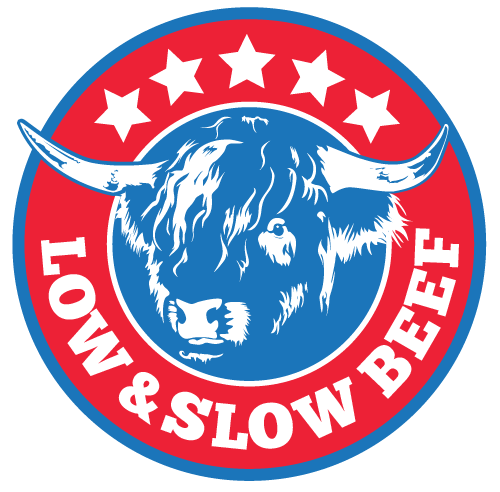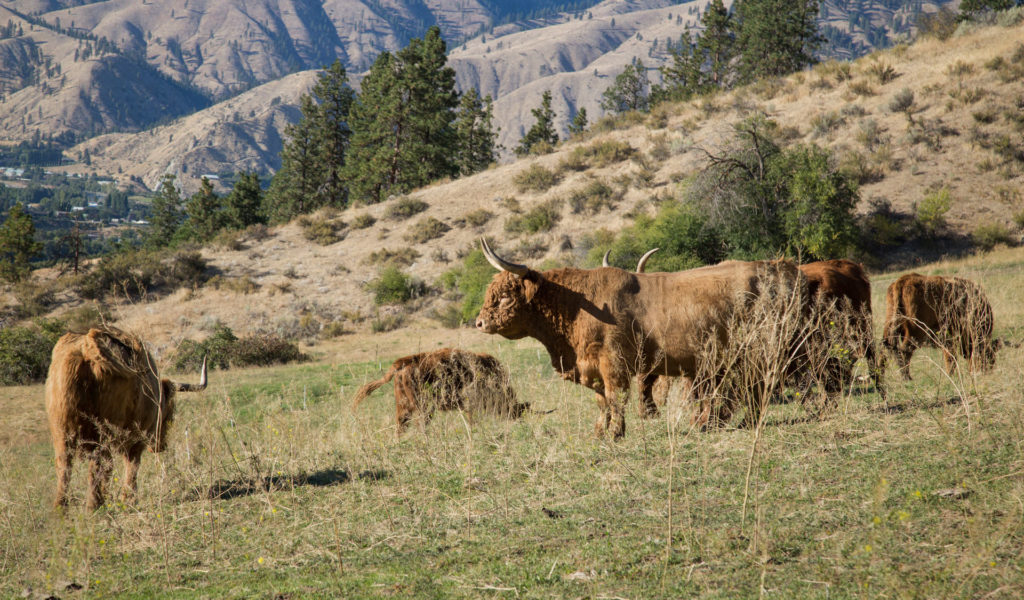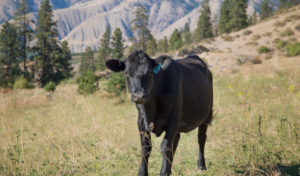
Scottish Highland
The Highland breed has lived for centuries in the rugged remote Scottish Highlands. The extremely harsh conditions created a process of natural selection, where only the fittest and most adaptable animals survived to carry on the breed.
Highlands. The extremely harsh conditions created a process of natural selection, where only the fittest and most adaptable animals survived to carry on the breed.
The Highland is the oldest registered breed of cattle, with the first herd book being established in 1884. Around that time, American cattlemen from the western U.S. recognized the natural qualities of the Highland animal and imported them to improve the blood lines of their herds. As a result, the Highland contributed in a great way to the success of the American cattle industry. Today’s market is demanding premium meat, yet leaner and lower in cholesterol. The Highland carcass is ideally suited to meet this challenge. Highland beef is meat that is lean, well marbled and flavorful, with little outside waste fat (the Highland is insulated by long hair rather than a thick layer of fat). For over 20 years, the Highland and Highland crosses have graded in the top of their respective classes at the prestigious National Western Stock Show in Denver, Colorado.
Angus
 The Angus breed began in the northern regions of England. Originally both red and black cattle were equally selected for in attempts to get high quality traits wherever possible. In the latter half of the 18th century, the cattle of the Aberdeen – Angus counties of northeast Scotland were being heavily used for the improvement of other regional cattle herds. Angus beef hardly needs an introduction; it is renowned for its fine marbling texture and superlative eating qualities. While the high quality traits of beef are not exclusive in the Angus, their numbers increased due to their consistency in producing quality. There is little lacking in the Angus breed; it meets the needs of a demanding cattle industry on a wide range of points.
The Angus breed began in the northern regions of England. Originally both red and black cattle were equally selected for in attempts to get high quality traits wherever possible. In the latter half of the 18th century, the cattle of the Aberdeen – Angus counties of northeast Scotland were being heavily used for the improvement of other regional cattle herds. Angus beef hardly needs an introduction; it is renowned for its fine marbling texture and superlative eating qualities. While the high quality traits of beef are not exclusive in the Angus, their numbers increased due to their consistency in producing quality. There is little lacking in the Angus breed; it meets the needs of a demanding cattle industry on a wide range of points.
Our Guarantee: If you’re not satisfied, we’re not satisfied.
Your satisfaction is our top priority. That’s why we will exchange or refund your order if you are not completely happy with your purchase of Low and Slow Beef. We will gladly offer a replacement or refund. Simply return to us within 14 days of your receipt of the product with a brief description of your reasons for return. Please contact us for details at 509-264-1069 or email at carnesfarms@gmail.com.
Cooking Tips:
GENERAL COOKING TIPS REGARDING GRASSFED MEATS:
• Grass-fed meat needs to be cooked at a lower temperature and should be monitored closely as the inside temperature of the meat when being cooked tends to go from warm to cooked in a short amount of time.
• I use a cooking thermometer to test the inside temperature during the cooking process.
• Keep in mind that a barbeque has many variables that effect the cooking temperature, such as wind, humidity, gas pressure and number of times the lid is opened.
• In addition to using a meat thermometer I always use a timer that sits next to the barbeque. Using these two tools I am able to cook grass-fed meat to the desired temperature every time.
Recipes and Cooking Instructions
Here are a few of our favorite ways to enjoy our beef. Check back periodically for new recipes!
BARBEQUING STEAKS:
1. Thaw the frozen steaks in the refrigerator for 36 to 48 hours prior to cooking. Never use the microwave to thaw steaks as it will cook the meat and make the meat tough. Never put a half frozen steak on the barbeque as the outside will end up overdone and the inside will remain uncooked.
2. I like to allow thirty minutes from the time I start preparing thawed steaks until the time I place them on the table to consume. Remember it took up to five years to produce these steaks, so please take some time to enjoy the cooking process and you will be pleasantly rewarded with a fantastic steak.
3. Place your meat thermometer, timer, resting plate and tinfoil and spatula next to your grill.
4. Preheat your barbeque to Medium and thoroughly scrape the grill prior to placing the steaks on. I like to allow the grill to cook on medium for about 8-10 minutes, scraping the grill in the beginning when cold then scraping the grill just prior to placing the steaks on.
5. Take the steaks out of the cryo-vacuum packages and provide a “quick rinse 1-2 seconds” in warm water then pat dry with paper towel.
6. If you desire salt, pepper or other seasonings try sprinkling the desired amount onto a flat surface then lay your steak on top of the seasoning, flip to cover both sides. By placing the salt, pepper or other seasons on the plate first it allows you to monitor the amount of seasoning that goes on the steak with accuracy instead of pouring it on directly to the meat.
7. Scrape the barbeque one last time prior to placing the steaks on. Lay the steaks on the grill and shut the lid. Set the timer for 4 minutes. Make sure the Grill is on Low to Med-Low.
8. After 4 minutes have passed, open the lid and flip the steaks, set the timer for 4 minutes, shut the lid.
9. After 8 total minutes have passed, open the lid and check the inside temperature of the steak by poking the meat thermometer into the middle of the steak. I poke the meat thermometer into the inside of the steak from the side of the steak which helps prevent the thermometer from going all the way through the steak thus providing an inaccurate temperature reading. I pull my steaks off the grill when the inside temperature reaches 125 degrees to 128 degrees. (this will provide a steak that is rare to medium rare after it has rested (wrapped in tinfoil for 8-10 minutes). If the inside temperature is below the desired level (125-128 degrees rare-medium rare, 128-132 degrees for medium), then flip the steak and cook for another 1-2 minutes per side until the desire temperate is achieved.
When grilling in the winter keep in mind that the outside temperature is much colder which in turn keeps my barbeque cooler and prolongs the cooking process, so make sure and take the outside temperature and conditions into effect when grilling.
10. When the steaks reach their desired temperature, pull off the grill immediately and wrap them into tinfoil. Next place a small kitchen towel over the tinfoil wrapped steaks. Let the meat rest on the table for 8-10 minutes. During this time the meat continues to cook and the muscle fibers begin to relax. When the meat relaxes it reabsorbs the juices. When you uncover the steaks you will notice the steaks are bathed in their juices. I like to pour this juice back over the steaks prior to serving.